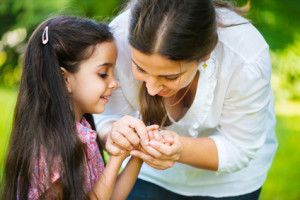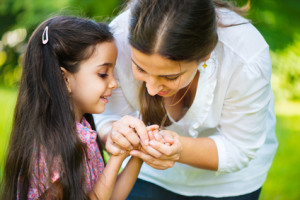by Serena Wieder, PhD, Co-Author with Stanley Greenspan, MD, of The Child With Special Needs
 The first important goal in treating children with MultiSystem Developmental Disorder (MSDD) is developing spontaneous interactive behaviors that are purposeful and intentional. Described below are examples of methods that increase affect and help children relate to and communicate with others.
The first important goal in treating children with MultiSystem Developmental Disorder (MSDD) is developing spontaneous interactive behaviors that are purposeful and intentional. Described below are examples of methods that increase affect and help children relate to and communicate with others.
These efforts require daily practice and can be incorporated into play sessions, FloorTime or other times when a caregiver devotes total attention to the child. The methods are part of the DIR (Developmental, Individual Differences, Relationship) model providing comprehensive approaches.
- Follow the leader. Do what the child does. Mutual attention develops through interaction. Never interrupt ongoing interactive play.
- Treat whatever the child is doing as intentional and purposeful. Your child may not know hot to initiate purposeful behaviors. By giving every move your utmost attention, interest and energy, you will convey that actions are meaningful- and will get a response.
- Extend the child’s desire and sometimes play dumb. When your child communicates the desire for something (taking your hand, looking, vocalizing, pointing), respond quickly– but not necessarily accurately–to stretch his desire into as many interactions as possible.
- Differentiate your actions from the child’s. Motor planning difficulties, low muscle tone, and poor “self-other differentiation” may cause her to take your hand to do something for her. Guide her to do what she wants by putting your hand over hers. Instead, position yourself in front of her, fact-to-face, or work at a mirror so she can see your expressions. Express pleasure for every move she makes.
- Help the child do what he wants to do. When he is purposeful (lining up object), hand him the next object. Then put the next item exactly where he would put it. Then put an object in the wrong place. Keep challenging him, gently.
- Have sensory, wind-up, and simple cause-and-effect toys available to entice the child’s interest and attention. Let him make his own moves. Initially, he may reject a toy you offer, but picky it up later. Don’t impose and overwhelm the child with the toys; be indirect.
- Give the child problems to solve. Use gentle obstruction, for example, to block the way so he must figure how to move around you. Or do something suprising, novel, or wrong (putting his shirt on his feet) so he will correct it.
- Don’t take “no” for an answer. Undoing what you did is a response! When she avoids or rejects your interaction, treat it as an error on your part. (“Oh, you don’t want this! Sorry! Here, try this toy.”) Your persistence will pay off as she realizes you will not stop pursuing her and treating what she does as intentional.
- Encourage exploration and the child’s choices. Rather than presenting structure tasks, provide a stimulating environment with a variety of toys, encourage initiation of actions. Learning happens when you invest you interest and enthusiasm in the child’s discoveries.
- Give old behaviors new meanings. When he spins, take his hand and dance with him, singing, “Ring around the Rosy.” When he runs back and forth, play tag or “London Bridge” and “lock him up”. When he lies down, dim the lights, provide a blanket, and sing a lullaby; when he arises, exclaim, “Good morning!” Every child will recognize these gestures that open the door to symbolic meanings. As he becomes more symbolic or more able to sequence actions, new meanings will emerge.
- Join the child in ways he enjoys, but do not back away from anger. Even if they go on and on, share pleasurable experiences, including infantile games (tickles, peek-a-boo, “this little piggy”) that he wants repeated. If at first, however, your involvement triggers anger, avoidance, whining or tantrums, continue anyway. Anger is an acceptable response and often precedes the ability to express pleasure.
- Open the door to symbolic play. As interaction increases, respond to real desires with pretend actions and props. If she wants to leave, offer the keys. Ask her to turn off the lights and help open the door. If she seems to search for food, offer pretend cookies. Use every opportunity to encourage the imitation of symbolic actions, even in the bathtub, where she is a captive audience in a familiar and supportive sensory environment.
- Work on multiple levels at once and be very persistent. Starting this intervention, you may be trying simultaneously to get his attention, focus on what he enjoys, and become interactive and communicative. Most important is maintaining mutual attention and engagement.
